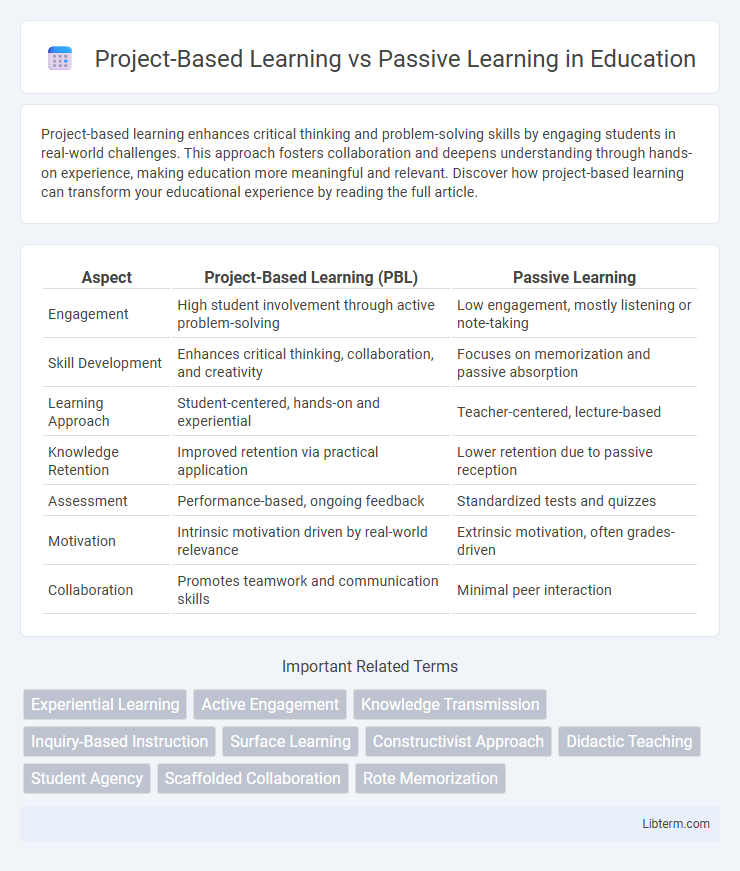Project-based learning enhances critical thinking and problem-solving skills by engaging students in real-world challenges. This approach fosters collaboration and deepens understanding through hands-on experience, making education more meaningful and relevant. Discover how project-based learning can transform your educational experience by reading the full article.
Table of Comparison
| Aspect | Project-Based Learning (PBL) | Passive Learning |
|---|---|---|
| Engagement | High student involvement through active problem-solving | Low engagement, mostly listening or note-taking |
| Skill Development | Enhances critical thinking, collaboration, and creativity | Focuses on memorization and passive absorption |
| Learning Approach | Student-centered, hands-on and experiential | Teacher-centered, lecture-based |
| Knowledge Retention | Improved retention via practical application | Lower retention due to passive reception |
| Assessment | Performance-based, ongoing feedback | Standardized tests and quizzes |
| Motivation | Intrinsic motivation driven by real-world relevance | Extrinsic motivation, often grades-driven |
| Collaboration | Promotes teamwork and communication skills | Minimal peer interaction |
Introduction to Project-Based Learning and Passive Learning
Project-Based Learning (PBL) engages students actively in real-world problem solving, fostering critical thinking, collaboration, and retention by involving hands-on projects and inquiry-based activities. Passive Learning, characterized by lectures and rote memorization, limits student interaction and often results in lower comprehension and engagement levels. Research indicates that PBL enhances deeper understanding and skill development compared to traditional passive instructional methods.
Core Principles of Project-Based Learning
Project-Based Learning (PBL) centers on active exploration, real-world problem solving, and student collaboration, contrasting sharply with passive learning's emphasis on memorization and listening. Core principles of PBL include student-driven inquiry, authentic tasks that connect to learners' lives, and iterative reflection to deepen understanding. This approach fosters critical thinking, creativity, and practical application, leading to improved retention and engagement compared to traditional passive learning methods.
Key Characteristics of Passive Learning
Passive learning involves students receiving information primarily through lectures, readings, or watching videos without active engagement or interaction. Key characteristics include limited critical thinking opportunities, minimal student participation, and reliance on memorization rather than application of knowledge. This approach often results in lower retention rates and reduced motivation compared to active, project-based learning methodologies.
Comparing Student Engagement Levels
Project-Based Learning (PBL) significantly enhances student engagement by involving learners in hands-on, real-world problem-solving activities that foster critical thinking and collaboration. In contrast, Passive Learning typically results in lower engagement levels as students receive information passively through lectures or rote memorization without active participation. Studies show that PBL increases motivation and retention by creating meaningful connections between content and practical application, making it a more effective approach for sustained learner involvement.
Impact on Critical Thinking and Problem-Solving Skills
Project-Based Learning (PBL) significantly enhances critical thinking and problem-solving skills by engaging students in real-world challenges that require analysis, evaluation, and creative solutions. In contrast, passive learning methods, such as lectures and rote memorization, often limit students' ability to apply knowledge effectively or think independently. Empirical studies show that PBL learners outperform passive learners in developing higher-order cognitive skills essential for innovation and adaptability.
Real-World Applications in Project-Based Learning
Project-Based Learning (PBL) immerses students in real-world applications by engaging them in complex, hands-on projects that develop critical thinking and problem-solving skills. This active approach contrasts with Passive Learning, which often involves memorization and limited interaction, reducing opportunities to apply knowledge to authentic scenarios. PBL enhances retention and prepares learners for practical challenges by fostering collaboration, creativity, and adaptability in dynamic environments.
Assessment Methods: Active vs Passive Approaches
Project-Based Learning employs active assessment methods such as performance tasks, presentations, and portfolios that require students to demonstrate understanding through practical application and critical thinking. Passive learning relies heavily on traditional assessments like multiple-choice tests and quizzes that measure memorization and recall rather than deep comprehension. Active assessment promotes engagement and real-world skill development, while passive techniques emphasize standardized evaluation and rote learning.
Benefits of Active Participation in Learning
Active participation in Project-Based Learning (PBL) fosters critical thinking, problem-solving skills, and real-world application by engaging students directly in hands-on tasks. Unlike Passive Learning, which often involves mere absorption of information, PBL enhances retention and deeper understanding through collaboration and iterative feedback. This dynamic approach promotes motivation and autonomy, leading to improved academic performance and long-term skill development.
Challenges and Limitations of Each Method
Project-Based Learning faces challenges such as resource intensiveness, requiring significant time, materials, and instructor expertise, which can limit scalability in large or underfunded classrooms. Passive Learning often results in low student engagement and retention, as it typically involves one-way information delivery without active participation. Both methods have limitations: Project-Based Learning may overwhelm students lacking self-regulation skills, while Passive Learning can stifle critical thinking and practical skill development.
Choosing the Right Approach for Different Learners
Project-Based Learning enhances critical thinking and collaboration by engaging learners in real-world problem-solving activities, making it ideal for kinesthetic and social learners. Passive Learning suits learners who benefit from structured environments with clear, concise information delivery, such as auditory or visual learners who prefer lectures and readings. Selecting the right approach depends on individual learning styles, motivation levels, and educational goals to maximize comprehension and retention.
Project-Based Learning Infographic

 libterm.com
libterm.com